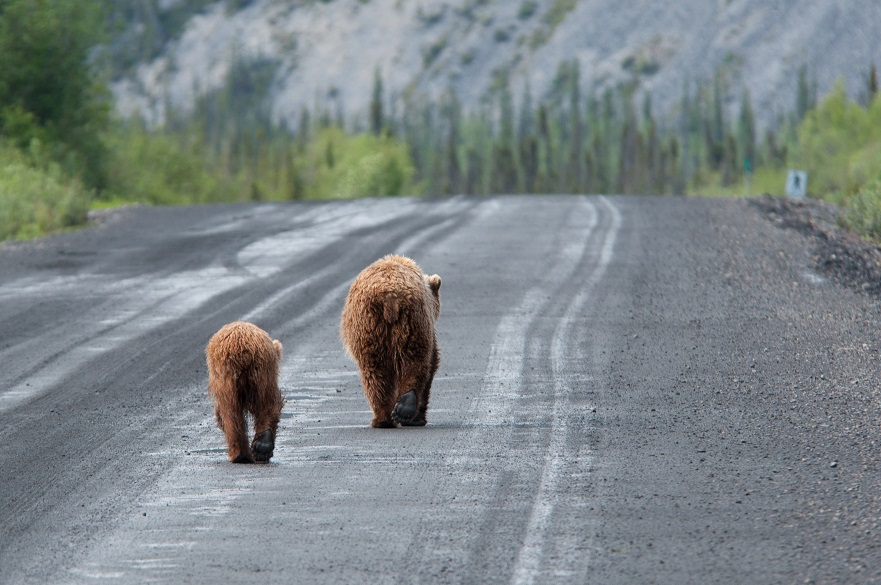Some female bears may select dens near to people to keep the threat of males away
By Dave Rogers | Published on 18 July 2022
Categories: Press office; Research; School of Animal, Rural and Environmental Sciences;


A study led by conservation experts at Nottingham Trent University and European partners involved monitoring populations of brown bears in the Cantabrian mountain range in northern Spain over 20 years.
Working with researchers at the Spanish National Research Council, the Biodiversity Research Institute in Spain, the University of León, and the Czech University of Life Sciences, they looked at changes in the habitat characteristics of dens used by females to give birth to cubs.
The researchers suggest that the more dominant and experienced females may pre-emptively occupy the best locations, with good food resources and at higher altitudes and near to rugged terrain.
These higher quality areas allow them to achieve higher fitness and limit the movement of their cubs and the likelihood of encountering other bears or people.
As the number of bears increased some females began to move to sub-optimal quality areas, lower in the valleys and closer to sources of human disturbance, such as trails and roads, with shorter distances between neighbouring bears’ breeding areas.
Male bears are known to steer clear of areas used by people and can kill new-born cubs – known as infanticide – to make females become receptive to mating again, so getting closer to humans would help them to avoid dangerous encounters which could end badly for them or their offspring.
The effect of increasing densities on bears’ spatial behaviour is poorly understood and monitoring characteristics relating to females with cubs is considered to be the most important component when assessing brown bear populations.
“The Cantabrian brown bear is an example of a vulnerable large carnivore population that has recently increased in size,” said researcher Dr Antonio Uzal, an expert in wildlife conservation in Nottingham Trent University’s School of Animal, Rural and Environmental Sciences.
He said: “As populations increase, the competition for space and resources does too. Restricted habitat availability may promote encounters among bears during the mating season and this in turn can lead to a higher prevalence of infanticide events.
“Our findings may suggest that some bears used areas nearer to human activity and settlements and this would enable them to segregate from adult male bears, which are known to avoid such areas.
“The research also supports a well-established theory in ecology that competition for territories results in the most dominant individuals holding the higher-quality areas earlier while the weakest are forced to find sub-optimal habitats.
“Bears nearing human activity brings obvious challenges too, however, such as potential encounters with people and a higher likelihood of animals being killed on roads. Certain areas might also need to be closed to access at particular points of the year.“From a conservation point of view our findings are significant, as we can identify critical habitats at certain periods in the year and potentially manage activities in these areas.”
The study is published in the journal Mammal Research.
Notes for Editors
Press enquiries please contact Dave Rogers, Public Relations Manager, on telephone +44 (0)115 848 8782, or via email.
Nottingham Trent University (NTU) received the Queens Anniversary Prize for Higher and Further Education in 2021 for cultural heritage science research. It is the second time that NTU has been bestowed the honour of receiving a Queen’s Anniversary Prize for its research, the first being in 2015 for leading-edge research on the safety and security of global citizens. The Research Excellence Framework (2021) classed 83% of NTU’s research activity as either world-leading or internationally excellent. 86% of NTU’s research impact was assessed to be either world-leading or internationally excellent. NTU was awarded Outstanding Support for Students 2020 (Times Higher Education Awards). It was the University of the Year 2019 (Guardian University Awards, UK Social Mobility Awards), Modern University of the Year 2018 (Times and Sunday Times Good University Guide) and University of the Year 2017 (Times Higher Education Awards). NTU is the 5th largest UK institution by student numbers, with over 33,000 students and more than 4,000 staff located across five campuses. It has an international student population of 4,000 and an NTU community representing around 160 countries. In the past 15 years, NTU has invested £450 million in tools, technology and facilities. NTU is in the UK’s top 10 for number of applications and ranked first for accepted offers (2019 UCAS UG acceptance data) It is also among the UK’s top five recruiters of students from disadvantaged backgrounds. 75% of NTU students go on to graduate-level employment or graduate-entry education / training within fifteen months of graduating (Guardian University Guide 2021). NTU is 4th globally (and 3rd in the UK) for sustainability in the 2021 UI Green Metric University World Rankings (out of more than 900 participating universities).